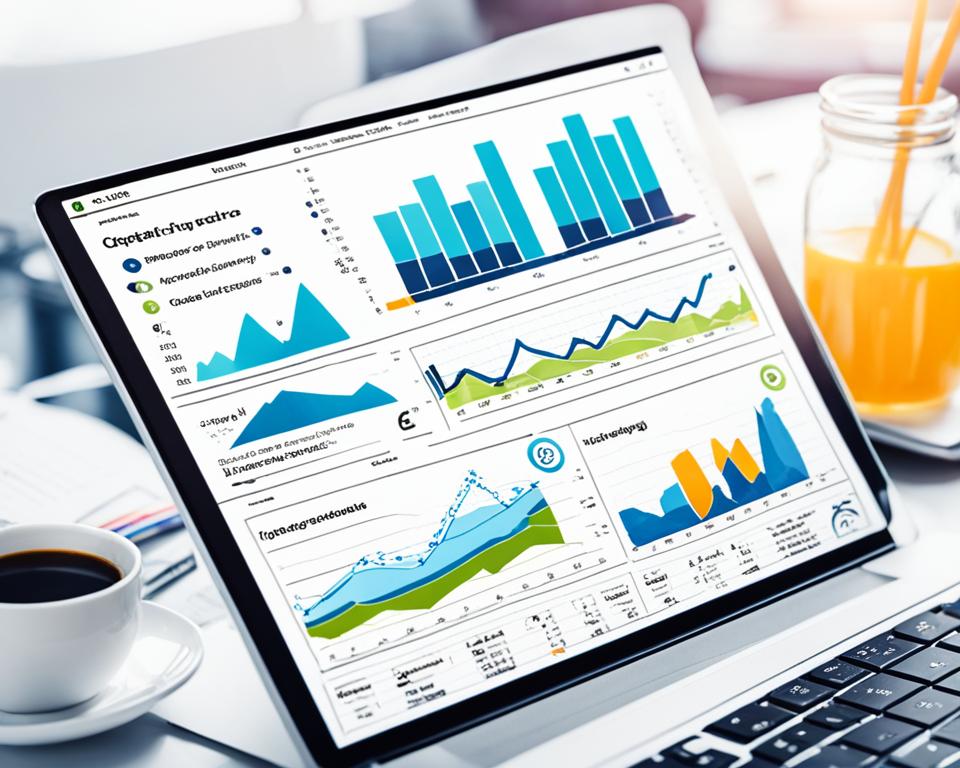In today’s digital world, using data is key to SEO success. Data for SEO helps unlock your website’s potential, increase organic traffic, and beat your competitors. This guide will give you the knowledge and strategies to use data insights and improve your SEO for long-term growth.
By learning about data’s role in SEO, you’ll see how it helps with search engine optimization. You’ll also discover how to make decisions based on data. This guide will show you how to use analytics to boost your online presence. You’ll learn to find the right data, analyze it deeply, and visualize it to make informed decisions.
Read interesting things at : seo-consul
Key Takeaways
- Understand the critical role of data in shaping an effective SEO strategy.
- Discover how to leverage internal and external data sources to enhance your SEO efforts.
- Explore data analysis techniques for uncovering valuable insights and trends.
- Learn how to develop a data-driven SEO strategy that outperforms your competitors.
- Discover the power of data visualization in communicating your SEO progress.
The Importance of Data in SEO
In the world of SEO, data is key to success. It helps SEO experts make better strategies. They can target the right people and get clear results.
Understanding the Role of Data in SEO
Data shows how your website is doing, what users do, and what search engines like. It helps you see how your SEO is working. With this info, you can make smart choices, find what needs work, and improve your SEO.
Data-Driven Decision Making for SEO
Good SEO plans use data to make choices. By looking at data, you find out what to create, how to structure your site, and which keywords to use. This way, you use your resources well and get real results from your SEO.
| Data Metric | Importance in SEO |
|---|---|
| Organic Search Traffic | Shows how well your SEO brings in the right visitors to your site. |
| Keyword Rankings | Keeps track of where you stand in search results for certain keywords. It shows how visible and competitive you are. |
| Bounce Rate | Tells you about how engaging your content is and if it matches what people are searching for. |
| Conversion Rates | Shows how well your SEO turns visitors into leads or customers. |
Using a data-driven SEO approach lets you fully use your online potential. With data for seo, seo data insights, and a data-driven seo strategy, you can make smart choices. This helps you improve your site and grow in search rankings.
Search Engine Optimization Data
In the fast-paced world of digital marketing, SEO data is key to success online. It offers a wealth of insights, from web analytics to keyword research and competitor analysis. By using this data, marketers can find new opportunities and make smart choices for their SEO.
SEO data is full of insights that help improve rankings, increase traffic, and boost conversions. It helps marketers understand what users want, find the best keywords, and see how well their content performs. This data is crucial for making your online presence better.
Embracing the Power of SEO Data Mining
SEO data mining is about collecting, analyzing, and understanding data to find patterns and insights. By exploring this data, marketers can learn more about their audience, competitors, and how search engines work. This knowledge is vital for success online.
- Keyword research: Find the best keywords for your business to improve your content and stay ahead.
- Search engine optimization data: Use web analytics to see what content works best and how to get more organic traffic.
- Competitor analysis: Look at what your competitors do well to find your own edge.
- User behavior analysis: Learn how people interact with your site to make it better for them.
Using search engine optimization data helps marketers make smart SEO choices. This leads to sustainable growth and long-term success.
| SEO Data Type | Insights Gained | Actionable Recommendations |
|---|---|---|
| Keyword Research | Find keywords that are popular but not too hard to get, matching your business goals. | Make your website and content better for those keywords. |
| Web Analytics | See where your traffic comes from, how users act, and how your content does to know what’s good and what’s not. | Improve your content plan, make your website easier to use, and keep users interested. |
| Competitor Analysis | Look at what your competitors do SEO-wise to find chances and weak spots. | Create an SEO plan that stands out and beats the competition. |
“In today’s digital world, search engine optimization data is key to lasting growth and success. By using data, marketers can make smart moves that elevate their online presence.”
Identifying Relevant Data Sources
For data-driven SEO, the first step is to find the right data sources. These can be from inside or outside your company. Each type offers important insights to improve your SEO strategy.
Internal Data Sources
Your own website and business data are full of information to help your SEO. Key internal data sources include:
- Google Analytics: Learn about user behavior, traffic sources, and how your site performs.
- Search Console: See how your site looks in search results and find ways to improve.
- CRM and sales data: Use customer info to understand what they need and like.
- Social media analytics: Check engagement and feelings on your social media channels.
External Data Sources
There are many external sources that offer valuable seo data sources for your analysis:
- Competitor research: Look at your competitors’ SEO strategies, content, and results to find ways to do better.
- Industry benchmarks: See how your website and SEO stack up against industry standards and best practices.
- Keyword research tools: Find relevant keywords, how often people search for them, and the competition to guide your content and optimization.
- Online surveys and user feedback: Get direct feedback from your target audience to understand their needs and problems better.
By using both internal and external data analysis for seo, you can get a full picture of your audience, competitors, and SEO performance. This helps you make smart decisions and improve your strategies.
| Internal Data Sources | External Data Sources |
|---|---|
| Google Analytics | Competitor Research |
| Search Console | Industry Benchmarks |
| CRM and Sales Data | Keyword Research Tools |
| Social Media Analytics | Online Surveys and User Feedback |
data fo rseo
Search engine optimization (SEO) has grown, making data more crucial. Data for SEO gives insights that help businesses improve their online presence. With this data, companies can make smart choices that lead to real results.
Data for SEO helps us understand how users behave, what they search for, and what others in the industry are doing. SEO experts use this data to spot opportunities, make content better, and target more effectively. From finding the right keywords to checking how content performs, data-driven SEO helps improve rankings and increase organic traffic.
| Data Source | Insights Gained |
|---|---|
| Search Console | Keyword performance, click-through rates, and impressions |
| Google Analytics | User behavior, traffic sources, and content engagement |
| Competitive Analysis Tools | Competitor’s SEO strategies, link profiles, and content performance |
Using data for SEO in your strategy helps you make better choices. It lets you optimize your content and grow your online presence over time. The key is to keep gathering, analyzing, and acting on this valuable data.
“Data-driven SEO is the foundation for long-term, sustainable success in the ever-evolving world of search engine optimization.”
Data Analysis for SEO
Data analysis is key in SEO. It helps find insights to shape your strategy. By looking closely at data, you can spot patterns and trends. These insights help improve your online presence and boost your search rankings.
Data Cleaning and Preprocessing
First, make sure your data is clean and accurate. This means doing data cleaning and preprocessing. You need to fix errors, fill in missing values, and make sure everything is consistent. This step is crucial for reliable data analysis for SEO.
Exploratory Data Analysis
After cleaning your data, it’s time for exploratory data analysis. You’ll look at your data from different sides to find patterns and trends. Tools like visualization and statistical analysis help you spot important insights. These insights are key for a data-driven SEO strategy.
“Data analysis is the heart of effective SEO. By understanding your data, you can make informed decisions that will maximize your online visibility and drive meaningful results.”
SEO Data Mining Techniques
In the world of SEO, data mining is key for finding hidden insights and making smart choices. Techniques like clustering analysis and association rule mining are game-changers for your SEO data mining. They help you understand your audience better and improve your SEO strategy.
Clustering Analysis
Clustering analysis groups your data into clusters based on what they have in common. This lets you see who your audience is, what they like, and how they interact with search engines. With this info, you can make your SEO strategy more targeted and effective.
Association Rule Mining
Association rule mining finds hidden links and patterns in your data. It shows you what affects search engine performance and user interest. This knowledge helps you tailor your SEO strategy for better results.
Using these advanced SEO data mining methods leads to smarter, data-driven decisions. They help you spot opportunities to improve your SEO tactics and stay ahead in the SEO game.

Developing a Data-Driven SEO Strategy
In today’s digital world, knowing how to use data is key for SEO success. By using data, businesses can make smart choices, improve their strategies, and grow their online presence.
At the heart of a data-driven SEO strategy is gathering and analyzing data from different places. This means tracking important metrics, looking at website stats, and doing deep keyword research. By looking at this data, marketers can find patterns and trends that help them improve their SEO.
Harnessing Data for Informed Decision-Making
Using a data-driven SEO strategy helps marketers make choices that meet their goals. By looking at data, they can see what works best, make their content better, and use their resources wisely. This way, SEO efforts are focused and have a big impact, leading to clear results.
Continually Refining and Adapting
A data-driven SEO strategy is an ongoing process. It involves always checking and improving based on new data. By keeping an eye on SEO trends and user behavior, businesses can change their strategies to stay ahead. This keeps the SEO strategy working well over time.
| Key Elements of a Data-Driven SEO Strategy | Benefits |
|---|---|
|
|
By using a data-driven SEO strategy, businesses can tap into the power of data insights. This leads to better SEO results. With a methodical and flexible approach, they can stay ahead, adapt to new trends, and find new chances for success online.
SEO Data Visualization
Data visualization is key in the world of SEO strategy. It turns complex SEO data into easy-to-understand visuals. This helps you see your online performance clearly and spot chances to improve.
Data Visualization Tools and Techniques
Check out the newest tools and methods for data visualization to boost your SEO reports. Tools like interactive dashboards and infographics make your findings clear and grab your audience’s attention.
- Google Data Studio: A powerful data visualization platform that seamlessly integrates with your SEO data sources.
- Tableau: A versatile data visualization software that offers advanced analytical capabilities for comprehensive SEO reporting.
- Infogram: A user-friendly tool for creating visually appealing infographics and charts to showcase your SEO data.
- Plotly: An open-source data visualization library that allows for the creation of interactive, web-based visualizations.
Using these tools and methods, you can make complex SEO data easy to see and act on. This leads to a more data-driven seo strategy for your business.
| Tool | Key Features | Pricing |
|---|---|---|
| Google Data Studio | Real-time data reporting, custom dashboards, integration with Google Analytics | Free |
| Tableau | Advanced data visualization, interactive dashboards, data blending capabilities | Starts at $70/user/month |
| Infogram | Intuitive infographic and chart creation, collaboration features, pre-designed templates | Starts at $19/month |
| Plotly | Open-source data visualization library, interactive charts and graphs, customizable templates | Free and paid plans available |
“Data visualization is the art of telling a story with data, making complex information accessible and engaging.”
Interpreting SEO Data Insights
In the world of SEO, data is crucial for unlocking valuable insights. These insights can help boost your online presence. By looking closely at the data, marketers can spot patterns and trends. This is key to a successful seo data insights strategy.
Identifying Patterns and Trends
First, you need to find patterns and trends in your data. This means looking at search engine rankings, traffic sources, and user behavior. By understanding these trends, you can make smart choices about where to use your resources.
For instance, you might see organic traffic dropping on a certain page. After digging deeper, you find the content isn’t relevant anymore. So, you update or change the content to draw in users again.
| Metric | Trend | Insight |
|---|---|---|
| Organic Traffic | Declining | Content needs to be updated or optimized |
| Bounce Rate | Increasing | User experience issues that need to be addressed |
| Conversion Rate | Stable | Existing strategies are effective, focus on scaling |
By keeping an eye on these patterns and trends, you can tweak your seo data insights strategy. This helps you stay ahead of your competitors and meet your audience’s changing needs.

Data-Based SEO Tactics
Using data is key for a strong SEO strategy. It helps you boost your online presence and get more visible in search results. Let’s look at how data can help with keyword research and content optimization.
Keyword Research and Optimization
Finding the right keywords is vital for SEO. Data-driven keyword research helps you spot search trends, understand what users want, and pick the best terms for your business. By looking at search volume, competition, and how users behave, you can make your keyword strategy better. This ensures your content meets what your audience is looking for.
- Use keyword research tools to get detailed data on search volume, trends, and competition.
- Study how users search and what they want to find to pick the best keywords for your audience.
- Keep updating your keyword strategy as search trends and user behavior change.
Content Optimization
Optimizing content with data is key to better search rankings and engaging with users. By using SEO data, you can make content that speaks to your audience and meets their needs. Data helps with everything from on-page optimization to planning your content strategy.
| Data-Based SEO Tactic | Benefits |
|---|---|
| Keyword-focused content creation | Improved search visibility and organic traffic |
| Content performance analysis | Finding out which content works best for optimization |
| User engagement tracking | Better user experience and more conversions |
By using data in SEO, you can make the most of your efforts. This brings in more qualified traffic and helps you reach your business goals.
Monitoring and Adjusting Your SEO Strategy
In the fast-changing world of SEO, using data is key to success. It’s important to keep an eye on and tweak your data-driven seo strategy with seo data insights. This helps you stay ahead in the search game.
It’s vital to track important performance indicators (KPIs) to see where you can get better. Look at organic traffic, keyword rankings, and conversion rates. This helps you see what’s working and what’s not, so you can make smart changes.
Checking your seo data insights often lets you spot new trends and adjust to changes in search engines. You can improve your keyword use, make your content better, or boost your technical SEO. Staying data-driven keeps your strategy up-to-date and effective.
SEO is all about making changes and getting better. By always looking to improve and making decisions based on data, you can tweak your data-driven seo strategy. This way, you meet your audience’s needs and beat the competition.
| Key Performance Indicator | Importance for Monitoring | Insights Gained |
|---|---|---|
| Organic Traffic | Measure the effectiveness of your overall SEO strategy | Identify opportunities to improve content, user experience, and technical optimizations |
| Keyword Rankings | Evaluate the success of your keyword targeting and optimization efforts | Uncover new keyword opportunities and refine your content strategy |
| Conversion Rates | Assess the quality of your traffic and the effectiveness of your landing pages | Optimize your content and user experience to drive better conversions |
By always keeping an eye on and adjusting your data-driven seo strategy with seo data insights, you can stay ahead. This keeps you strong online in your field.
Data Privacy and Ethical Considerations
Exploring SEO means looking closely at data privacy and ethical practices. Today, data is key to digital marketing. Keeping our audience’s trust and privacy is very important.
Responsible Data Collection and Usage
Starting with data privacy means collecting and using data responsibly. We must follow all rules and standards for SEO data. This means getting clear consent from users, being open about how we use their data, and keeping sensitive info safe.
- Follow data privacy laws and rules in your area
- Use strong security to protect user info
- Tell users how their data will be used and let them choose not to share
- Check and update how you collect and use data often
Being ethical in SEO data practices is more than just following laws. It’s about being open, accountable, and respectful to our audience. Protecting user data helps us build trust and make SEO that really helps our customers.
“Data privacy is not just a legal requirement, but a moral obligation. As SEO professionals, we have a responsibility to safeguard the information entrusted to us and use it in a way that benefits our audience.”
As digital marketing changes, keeping up with data privacy and ethical SEO data practices is key to our success and growth.
Conclusion
In this guide, we’ve looked at how data is key in search engine optimization (SEO). We’ve seen how to use data to make smart SEO choices. This helps you grow your online presence in a lasting way.
We’ve covered different types of data you can use for SEO. This includes both internal and external sources. With these, you can make choices based on facts, not just guesses.
Now, you know how to analyze data to find important insights. This can help you shape your SEO plans. For example, you can use data to find groups of people interested in your content or to see how to make your content better.
The secret to doing well is having a strong SEO strategy based on data. This means using data to see, understand, and act on it. By doing this, you can keep your SEO efforts up to date with the changing online world.



